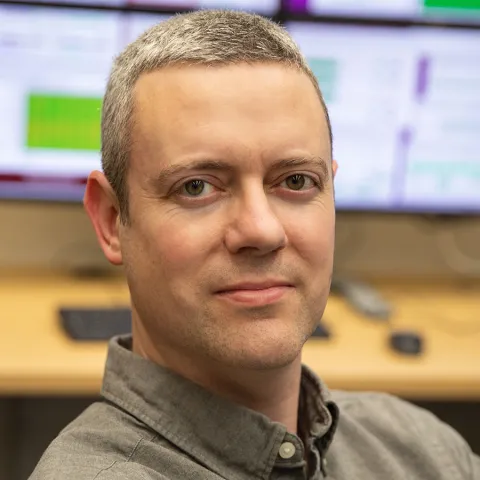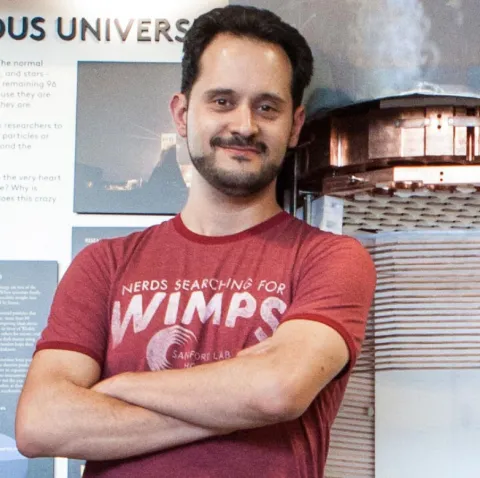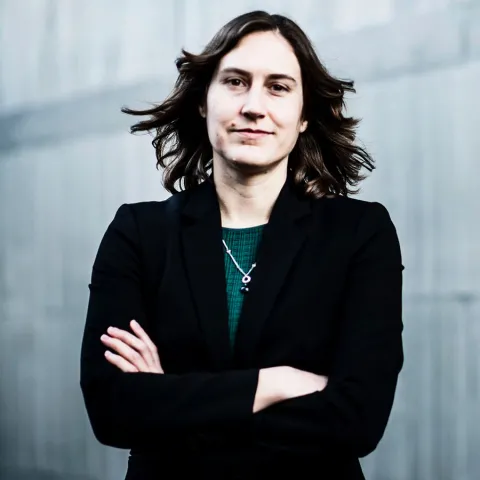Neutrinos, dark matter, black holes—oh my! Unlock the mysteries of the universe during virtual Neutrino Day
Join our line-up of speakers virtually on July 6-11 to investigate answers to the matter mysteries floating around the cosmos
Each day, scientists around the world conduct research that could be key to unlocking the mysteries of the universe. From neutrino oscillation to dark matter to the formation of black holes, the approaches to solving these cosmic conundrums seem to be as long as the list of mysteries themselves. For scientists and science lovers alike, this can seem overwhelming. Many wonder how they can even begin to learn more about our vast, mysterious universe.
Neutrino Day: A Matter Mystery, which takes place July 6-11, brings the experts to you. In addition to a variety of virtual activities for all ages, Sanford Underground Research Facility (Sanford Lab) will host daily science talks with scientists who are experts on a variety of cosmic phenomena.
Science comedian Brian Malow will lead daily discussions, taking us on a journey through the universe—from the Big Bang to neutrinos to dark matter to the fate of the universe. These science talks will be held at 10 a.m. each day (Tuesday, July 7, through Friday, July 10).
Adding gravity—and a bit of levity
Brian Malow has worked in science communications at the North Carolina Museum of Natural Sciences in Raleigh, blogged for Scientific American and is currently freelancing as a speaker, science comedian, consultant, writer and producer. Self-titled “Earth’s premier science comedian,” Malow is much more than an established science communicator, he is an out-of-this-world funny guy.

“When I became a comedian, my love of science was evident from the beginning of my geeky act,” Malow said. “Eventually, I came up with the title, ‘science comedian,’ and cut everything else away. That led to science communication projects, like making science videos for Time Magazine.”
Malow’s comedy has been performed for the American Chemical Society, the National Association of Science Writers, Apple, Dell and Microsoft, just to name a few. His Neil Armstrong routine was once even heard aboard an orbiting Space Shuttle, the STS-44.
Malow said he relates to his audiences through this quote by Isaac Asimov, an American writer and professor of biochemistry: “The most exciting phrase to hear in science, the one that heralds new discoveries, is not ‘Eureka!’ but ‘That's funny.’” Malow adds, “For me, the quote is relevant to comedians and scientists. I like finding little connections between these two; I always have.”
In addition to the daily interviews with scientists, Malow will also perform his stand-up comedy special “Just Add Gravity” on July 11 at 2 p.m.
“Right after the Big Bang, energy condenses into mostly hydrogen and a little helium, and that's it. But just add gravity to the early universe, and it results in stars, which create many of the other elements, which make everything interesting possible,” Malow said. “Without gravity, you would just have this boring universe of hydrogen with just a little bit of helium.”
The Big Bang
What exactly is the Big Bang? How did something so expansive, such as the universe, come to be? Mark Hanhardt, Sanford Lab experiment support scientist, will tackle these questions with some help from Malow on July 7.
Hanhardt, a Ph.D. candidate in physics at the South Dakota School of Mines & Technology (and part-time supervillain), works with the CASPAR project, which is hoping to learn more about how certain elements are created in dying stars.

“My interest in the Big Bang stems from my interest in something called the cosmic microwave background,” Hanhardt said. “The entire universe is bathed in a signal, this mysterious radio signal that seems to be coming from every direction and going towards every direction. This signal—this gorgeous song—can tell us so much about the early universe and the Big Bang, if we have the ability and imagination to listen to it.”
When Hanhardt isn’t studying science or obsessing over this cosmic symphony, he is preparing for his life as a super villain.
“My greatest fear is that it's going to be some sort of ridiculous superpower, like the ability to read a book 1.1 times faster than normal, or like the ability to walk on solid objects, which is something I can already do,” Hanhardt said. “Of all the different mutations you can get out there, there are only a handful that are useful or impressive, but there are a whole bunch more that are just entirely unnoticeable.”
Elusive neutrinos
The future Deep Underground Neutrino Experiment, or DUNE, hopes to learn a lot more about an elusive particle called a neutrino. Dr. Ryan Patterson, DUNE’s physics coordinator and professor of physics at the California Institute of Technology, will join Brian Malow on Wednesday, July 8, to discuss neutrinos and the DUNE project.
“Neutrinos are ubiquitous. They are produced in huge numbers in the sun, in huge numbers in radioactive decay and in all sorts of processes in the universe,” Patterson said. “But they are so weakly interacting that it is very hard to measure them very well, so we are still learning things about them.”

Patterson's current research focuses on how neutrinos can be used to explore supernova dynamics and nuclear structure, broad searches for signatures of new physics and the development of detectors and analytical methods for particle physics research.
“What we don’t know is if that mystery is just around the corner, or if it’s a million miles away,” Patterson said. “I think that would help guide the field a lot, to know what the task ahead truly is.”
A dark matter mystery
Dr. Simon Fiorucci joins Malow on Thursday, July 9, to discuss yet another matter mystery: dark matter.
A physicist at Lawrence Berkeley National Laboratory and operations manager for the LUX-ZEPLIN (LZ) experiment located at Sanford Lab, Fiorucci has been studying dark matter since 2002.

“We know there is dark matter out there. We know there is a lot of it—just from indirect observation of how the universe is put together and moves—but we’ve never been able to pinpoint what it is,” Fiorucci said. “For nearly 30 years, experiments have been trying to detect something that could make up this dark matter.”
While these experiments may not have found dark matter, that does not mean they were a failure. They have narrowed the search even further, demonstrating all the places dark matter isn’t hiding.
In 2020 LZ, the much larger and far more sensitive cousin to the LUX dark matter detector, will begin its search for WIMPs, weakly interacting massive particles, a leading contender to be a dark matter particle.
The end of the universe
Dr. Katie Mack studies a range of cosmological topics, from the beginning of the universe to the end of the universe and everything in between. A theoretical astrophysicist, Mack is an assistant professor of physics at North Carolina State University and a member of the Leadership in Public Science Cluster. Throughout her career, she has studied dark matter, the early universe, galaxy formation, black holes, cosmic strings and the ultimate fate of the cosmos.

“I've done a little bit of work on the early universe and the processes that happened at the very, very beginning but I am also working on stuff around one of the possibilities for the end of the universe, which is called vacuum decay—a kind of instability built into physics that allows the universe to be destroyed by this quantum process,” Mack said.
As a science communicator, Mack has been published in Scientific American, Slate, Sky & Telescope, Time.com and Cosmos Magazine, where she is a columnist. She is also a 2020 TED fellow, sparking positive change around the world.
In her book, The End of Everything (Astrophysically Speaking), Mack explores five possible ways the universe might end, how these possibilities were first determined and what evidence we have for or against each being the fate of the cosmos.
Investigate Matter Mysteries at Neutrino Day
From the beginning of the universe to its eventual demise, our speakers will explore landmark discoveries and unanswered questions during Neutrino Day: A Matter Mystery.
To join in on the fun, visit our Neutrino Day hub at www.neutrinoday.com, where you can find activities for kids of all ages, science talks, virtual facility tours and more.
